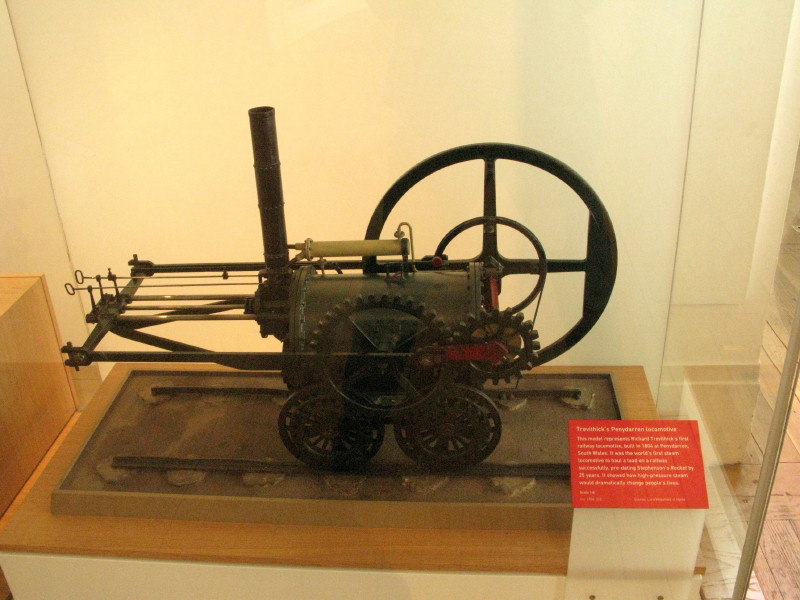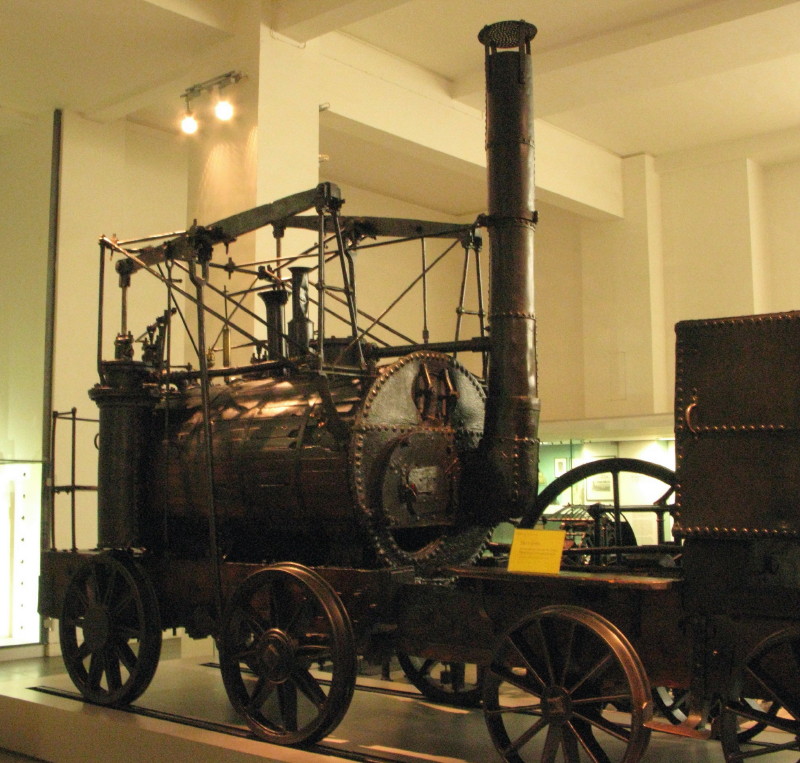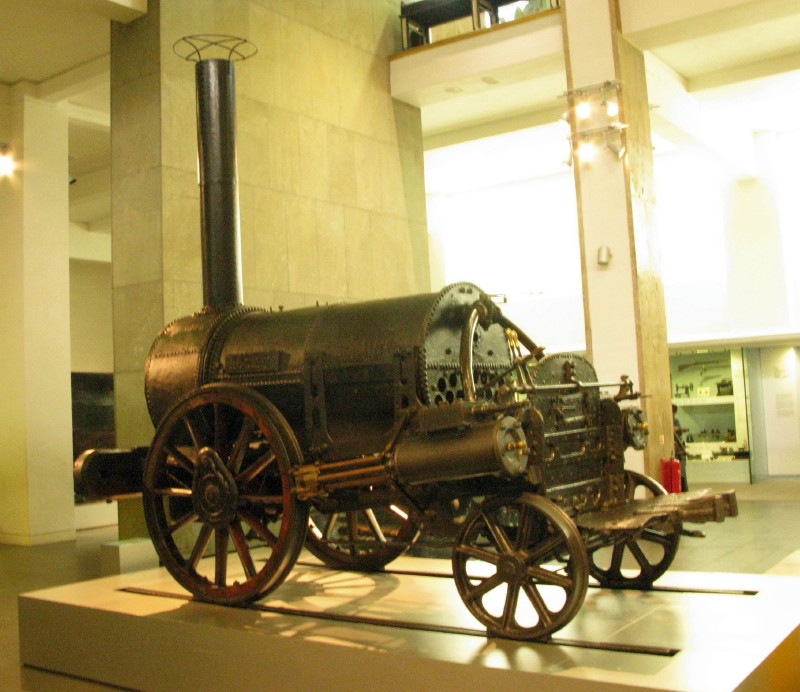
Richard Trevithick’s, and the world’s, first locomotive of 1804. A model of the first locomotive in the Science Museum. See how similar that is to the engine in the museum? The cylinder here is placed horizontally – it is at full out stroke in the model. The cylinder has been placed vertically in the museum’s engine and it has no wheels because it was an industrial engine but the lineage of the engine is unmistakeable. Watt may have powered the Industrial Revolution in the beginning but this is what really got things moving – literally in more ways than one.

Trevithicks later ‘Catch-me-who-can’ the 1808 locomotive that ran in London. This is similar in layout to the Science Museum engine. The connecting rod going directly to the crankpin on the driving wheel so no gears are necessary. This engine ran up to 20 kph. You can clearly see the exhaust steam pipe to the smoke stack and the thicker pipe around it for heating the water supply.

Puffing Billy. This is the world’s oldest surviving steam railway locomotive. Built in 1814 it carted coal 8 km from a colliery in northern England to a jetty on the river Tyne. Notice that it uses the same firebox and smoke stack arrangement that Trevithick pioneered. Now there are two cylinders and they are no longer inside the boiler. There is an extraordinary collection of levers and rods above the boiler but the crosshead has been dispensed with. Exhaust steam into the smoke stack just like Trevithick did.

Camera shake I am afraid. Notice that the connecting rod does not go to a crank on the wheel; there is a shaft with a gear behind the wheel.

Here is the very famous Rocket by Robert Stephenson. Before it was sent to the museum it was ‘restored’ at the Stephenson’s workshop. In fact they modernised it and put on stuff that had never been on the original engine. Over the years the museum has removed all the un-original stuff from it leaving us with just this.
I quote from the Science Museum http://www.sciencemuseum.org.uk/objects/nrm_-_locomotives_and_rolling_stock/1862-5.aspx?keywords=rocket
Quote:
Rocket 1829 Robert Stephenson's Rocket marks one of the key advances in railway technology. It also confirmed Stephenson as one of the premier engineers of his age and as a major engineering contractor for the emerging railway network, both in Britain and abroad. The locomotive was built to compete in the Rainhill Trials, held by the new Liverpool & Manchester Railway, to choose between competing designs. The performance of Rocket showed it to be the most successful of the contestants. It also convinced the railway company that the alternative possibility of using stationary steam engines to haul carriages by cables was not worth pursuing. Rocket established the basic architecture for the steam locomotive. The main features were: a multi-tubular boiler, to improve the heat transfer from the firebox gases into the boiler water; the 'blast pipe' which used the steam exhaust to improve the air draught through the firebox; and direct coupling, by connecting rods, from the pistons to the driving wheels.
The result was a dramatic improvement on contemporary locomotives, and at Rainhill a speed of 29 mph was achieved. The basic design principles embodied in Rocket carried through to the last steam locomotives built in Britain during the 1960s.
The result was a dramatic improvement on contemporary locomotives, and at Rainhill a speed of 29 mph was achieved. The basic design principles embodied in Rocket carried through to the last steam locomotives built in Britain during the 1960s.
This is on the official website of the Science Museum. I have highlighted the bits in that quote that I object to. It is perpetuating the myths and legends about this man at the expense of my hero, Richard Trevithick. I have shown you that he incorporated the ‘blast pipe’ on his very first locomotive and it was standard practice on all his high pressure engines yet here they imply that it was Stephenson who established its use. So to for the direct coupling of the cylinder to the wheels – look at ‘Catch-me-who-can’ as it does precisely that. The multi tubular boiler design was new but it was not Stephenson’s idea, it was a colleague of his father who had a financial interest in the venture who introduced the idea and insisted that it be used. It is a better idea than Trevithick’s original return flue idea but Trevithick had made the hot gases pass twice through the water space also looking to improve the heat transfer.. Rocket was a wonderful engine but this popular exaggeration of its attributes disgusts me; especially when an institution like the Science Museum does it.
Puffing Billy is the oldest surviving locomotive in the world. It was built in 1814 and was used to haul coal 8 km to the river Tyne up Newcastle way. Now note that it was operational 15 years before Stephenson’s famous Rocket let alone that Trevithick’s first locomotive had run 25 years previously.

Picture of model of Rocket. This is as it was for the Rainhill trials. Later the pistons were moved down lower as you see in the first photo; they caused the engine to rock less when lying almost horizontally. Robert Stephenson’s father, George, was the engineer who built the railway line.
The Rainhill trials were to select the locomotives for use on the new Liverpool & Manchester Railway. Liverpool was the port by which cotton was imported and sent to Manchester where the spinning and weaving mills were. The finished goods were then exported to the world through Liverpool.
This quote from http://www.spartacus.schoolnet.co.uk/RAliverpool.htm shows that the canal owners were very worried by the threat of a railway.
Quote:
The proposed Liverpool & Manchester Railway was a serious economic threat to the Bridgewater Canal. that was making a fortune by shipping goods between Liverpool and Manchester. In 1825 shares in the company, originally purchased at £70, were selling at £1,250 and paying an annual dividend of £35. The Marquis of Stafford, who became the principal owner of the canal after the death of the Duke of Bridgewater, was making an annual profit of £100,000 from the venture, and understandably led the fight against the planned railway. Turnpike Trusts, coach companies and farmers also voiced their opposition. The total quantity of goods passing between Liverpool and Manchester is estimated to be 1,000 tons per day. The average length of time taken by canal is 36 hours. The average charge has been 15s a ton. By the projected railroad, the transit of goods between Liverpool and Manchester will be four of five hours, and the charge to the merchant reduced by at least one-third.
The last line stating that the freight charge would be one third less and the travel time about one eighth compared to the existing canal. When I showed the picture of the canal lock on the Lot river I said I would show why they were superceeded by the railways. Well this is the reason. And in due course the railways were superceeded by trucks.


.
No comments:
Post a Comment